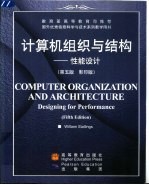

计算机组织与结构 性能设计 英文版PDF电子书下载
- 电子书积分:20 积分如何计算积分?
- 作 者:(美)William Stallings著
- 出 版 社:北京:高等教育出版社
- 出版年份:2001
- ISBN:7040100975
- 页数:748 页
PART ⅠOVERVIEW 1
Chapter 1 Introduction 3
1.1 Organization and Architecture 5
1.2 Structure and Function 6
1.3 Outline of the Book 12
1.4 Internet and Web Resources 15
Chapter 2 computer Evolution and Performance 17
2.1 A Brief History of Computers 19
2.2 Designing for Performance 39
2.3 Pentium and PowerPC Evolution 43
2.4 Recommended Reading and Web Sites 46
2.5 Problems 47
PART Ⅱ THE COMPUTER SYSTEM 49
Chapter 3 System Buses 51
3.1 Computer Components 53
3.2 Computer Function 56
3.3 Interconnection Structures 69
3.4 Bus Interconnection 71
3.5 PCI 80
3.6 Recommended Reading and Web Sites 89
3.7 Problems 90
Appendix 3A:Timing Diagrams 92
Chapter 4 Internal Memory 95
4.1 Computer Memory System Overview 97
4.2 Semiconductor Main Memory 103
4.3 Cache Memory 117
4.4 Pentium Ⅱ and PowerPC Cache organization 132
4.5 Advanced DRAM Organization 137
4.6 Recommended Reading and Web Sites 142
4.7 Problems 143
Appendix 4A:Performance Characteristics of Two-Level Memories 145
Chapter 5 External Memory 153
5.1 Magnetic Disk 155
5.2 RAID 163
5.3 Optical Memory 172
5.4 Magfletic Tape 177
5.5 Recommended Reading and Web Sites 178
5.6 Problems 179
Chapter 6 Input/Output 181
6.1 External Devices 184
6.2 I/O Modules 188
6.3 Programmed I/O 191
6.4 Interrupt-Driven I/O 195
6.5 Direct Memory Access 203
6.6 I/O Channels and processors 207
6.7 The External Interface:SCSI and Fire Wire 209
6.8 Recommended Reading and Web Sites 223
6.9 Problems 224
Chapter 7 Operating System Support 227
7.1 Operating System Overview 229
7.2 Scheduling 241
7.3 Memory Management 247
7.4 Pentium Ⅱ and PowerPC Memory Management 259
7.5 Recommended Reading and Web Sites 268
7.6 Problems 269
PART Ⅲ THE CENTRAL PROCESSING UNIT 271
Chapter 8 Computer Arithmetic 273
8.1 The Arithmetic and Logic Unit(ALU) 275
8.2 Integer Representation 276
8.3 Integer Arithmetic 282
8.4 Floating-Point Representation 298
8.5 Floating-Point Arithmetic 305
8.6 Recommended Reading and Web Sites 314
8.7 Problems 315
Appendix 8A:Number Systems 317
Chapter 9 Instruction Sats:Characteristics and Functions 323
9.1 Machine Instruction Characteristics 325
9.2 Types of Operands 331
9.3 Pentium Ⅱ and PowerPC Data Types 333
9.4 Types of Operations 336
9.5 Pentium Ⅱ and PowerPC Operation Types 349
9.6 Assembly Language 358
9.7 Recommended Reading 360
9.8 Problems 360
Appendix 9A:Stacks 364
Appendix 9B:Little-,Big-,and Bi-Endian 368
Chapter 10 Instruction Sets:Addressing Modes and Formats 373
10.1 Addressing 375
10.2 Pentium and PowerPC Addressing Modes 382
10.3 Instruction Pormats 388
10.4 Pentium and PowerPC Instruction Formats 397
10.5 Recommended Reading 402
10.6 Problems 402
Chapter 11 CPU Structure and Function 405
11.1 Processor Organization 407
11.2 Register Organization 409
11.3 The Instruction Cycle 414
11.4 Instruction Pipelining 419
11.5 The Pentium Processor 434
11.6 The PowerPC Processor 443
11.7 Recommended Reading 450
11.8 Problems 451
Chapter 12 Reduced Instruction Set Computers 455
12.1 Instruction Execution Characteristics 458
12.2 The Use of a Large Register File 462
12.3 Compiler-Based Register Optimization 467
12.4 Reduced Instruction Set Architecture 469
12.5 RISC Pipelining 476
12.6 MIPS R4000 480
12.7 SPARC 488
12.8 The RISC versus CISC Controversy 494
12.9 Recommended Reading 495
12.10 Problems 496
Chapter 13 Instruction-Level Parallelism and Superscalar Processors 499
13.1 Overview 501
13.2 Design Issues 506
13.3 Pentium Ⅱ 515
13.4 PowerPC 521
13.5 MIPS R10000 529
13.6 UltraSPARC-Ⅱ 531
13.7 IA-64/Merced 534
13.8 Recommended Reading 545
13.9 Problems 546
PART Ⅳ THE CONTROL UNIT 551
Chapter 14 Control Unit Operation 553
14.1 Micro-operations 555
14.2 Control of the Processor 561
14.3 Hardwired Implementation 573
14.4 Recommended Reading 575
14.5 Problems 576
Chapter 15 Microprogrammed Control 577
15.1 Basic Concepts 579
15.2 Microinstruction Sequencing 588
15.3 Microinstruction Execution 593
15.4 TI8800 605
15.5 Applications of Microprogramming 615
15.6 Recommended Reading 616
15.7 Problems 617
PART Ⅴ PARALLEL ORGANIZATION 619
Chapter 16 Parallel Processing 621
16.1 Multiple Processor Organizations 623
16.2 Symmetric Multiprocessors 625
16.3 Cache Coherence and the MESI Protocol 635
16.4 Clusters 642
16.5 Nonuniform Memory Access 646
16.6 Vector Computation 650
16.7 Recommended Reading 663
16.8 Problems 664
Appendix A Digital Logic 669
A.1 Boolean Algebra 670
A.2 Gates 672
A.3 Combinational Circuits 675
A.4 Sequential Circuits 696
A.5 Problems 707
Appendix B Projects for Teaching Computer Organization and Architecture 709
B.1 Research projects 710
B.2 Simulation Projects 710
B.3 Reading/Report Assignments 712
Glossary 713
References 725
Index 739
- 《计算机网络与通信基础》谢雨飞,田启川编著 2019
- 《大学计算机实验指导及习题解答》曹成志,宋长龙 2019
- 《联吡啶基钌光敏染料的结构与性能的理论研究》李明霞 2019
- 《异质性条件下技术创新最优市场结构研究 以中国高技术产业为例》千慧雄 2019
- 《卓有成效的管理者 中英文双语版》(美)彼得·德鲁克许是祥译;那国毅审校 2019
- 《计算机辅助平面设计》吴轶博主编 2019
- 《计算机组成原理解题参考 第7版》张基温 2017
- 《云计算节能与资源调度》彭俊杰主编 2019
- 《Helmholtz方程的步进计算方法研究》李鹏著 2019
- 《AutoCAD 2018自学视频教程 标准版 中文版》CAD/CAM/CAE技术联盟 2019
- 《全国高等中医药行业“十三五”创新教材 中医药学概论》翟华强 2019
- 《培智学校义务教育实验教科书教师教学用书 生活适应 二年级 上》人民教育出版社,课程教材研究所,特殊教育课程教材研究中心编著 2019
- 《指向核心素养 北京十一学校名师教学设计 英语 七年级 上 配人教版》周志英总主编 2019
- 《习近平总书记教育重要论述讲义》本书编写组 2020
- 《办好人民满意的教育 全国教育满意度调查报告》(中国)中国教育科学研究院 2019
- 《高等数学试题与详解》西安电子科技大学高等数学教学团队 2019
- 《北京生态环境保护》《北京环境保护丛书》编委会编著 2018
- 《教育学考研应试宝典》徐影主编 2019
- 《语文教育教学实践探索》陈德收 2018
- 《家庭音乐素养教育》刘畅 2018
